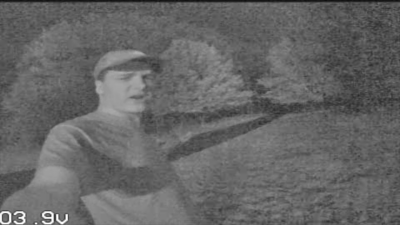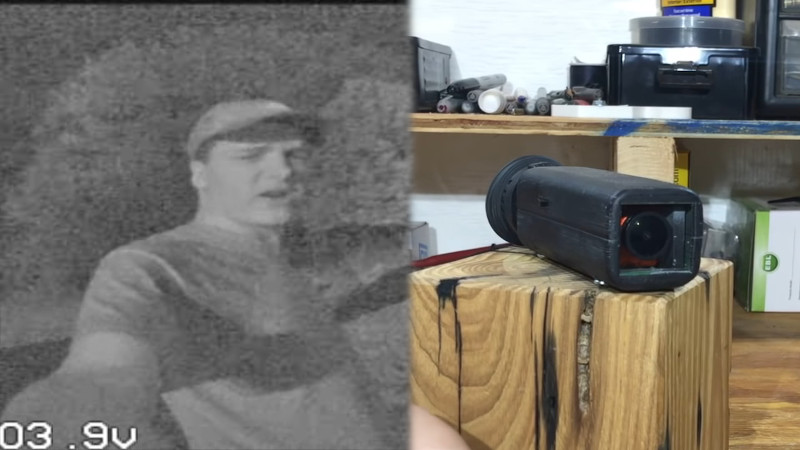Traditional military-grade nightvision gear has a history stretching back to the Second World War, relying on photomultiplier tubes to help soldiers see in the dark. Such devices have trickled down to the civilian market in intervening years, however other simpler techniques can work too. [Happy_Mad_Scientist] whipped up a simple nightvision monocular using a very sensitive camera instead.

The camera in question is the Runcam Night Eagle 2, prized for its 0.00001 lux sensitivity. Black and white only, its capable of providing vision in moonlight and starlight conditions without external illumination. In this project, it’s hooked up to a monocle display designed for use with drone FPV setups. With lithium batteries and a charge circuit hooked up, and everything stuffed inside a compact 3D printed case, the final result is a portable, pocket sized night vision device for under $200 USD.
[Happy_Mad_Scientist] notes that in starlight conditions, it provides an advantage over other nighttime Airsoft players relying on IR illumination to see in the dark. We can imagine it would perform well in concert with a bright IR headlamp for those times when there’s simply no ambient light available – particularly indoors.
If your tastes are more military-spec, consider this teardown of a high-end Norweigan device. Video after the break.
















a comparison of a modified high(er)-end mirrorless camera and Gen3 NVG
https://youtu.be/CFDNEjJ0cME?t=374
the same modified camera VS a prob. one of the best commercial digital NVGs available (costs $800-400 depending on the version, less if on sale)
https://youtu.be/e3SN-ZSG7ls?t=378
from 9:34 comparison against a gen3 tube as well
Oh passive night vision is better than IR illuminated, if you have a flashlight on your head that just makes you a good target for those who don’t.
Nothing beats the old microchannel plate detectors for coolness. High voltage and exceedingly low current operation means it can be powered piezoelectrically, just give a quick squeeze to the case for a minute’s operation and never worry about batteries.
I fear this would give people a very good reason to smack it…
One of the quickest paths to disappointment is trying to go cheap in the night vision game. A PVS14 is the only real contender for entry level night vision. The lag in camera units alone make it nearly worthless if you plan to actually move around.
“Entry Level” and links a $2,000-$5,000 set of NVGs. Really?
I wish I had the kind of money where I could “entry level” something for $2k
well wether you like it or not, there are a lot of tools where “entry level” means “expensive for the individual”, I would certainly enjoy an entry level DNA sequencer, or an entry level fusion reaction!
Hell, an entry level rebreather would be nice. But again even though they are very simple tools they still cost 5k+
lol, entry level doesn’t mean cheap, it means the lowest cost that an individual believes the value proposition starts to make sense. An entry level F1 team would be about a half a billion dollars. An entry level home in my area is about $200,000. An entry level Oboe is about $2,000. And yes, if someone is actually going to spend money on NODs, the lowest they should go is a PVS-14. These DIY ones are neat, but they are not commercially viable yet.
That’s literally entry level NVGs. IDK how you’re gonna clown on him because he didn’t lie to you.
There is a really good reason why a lot of people won’t buy a Gen3 and PVS14 or similar. They’re not in the USA. Export rules. In quite a lot of countries its also actually against the law for a private citizen to own anything more than a Gen1+, or some kinds of thermal equipment. That include a few European countries. As far as I know, Digital isnt limitied if its built, but might be if its bought.
There’s also rules about lasersights, all colours, and they might require a real license, even on a waterpistol.
why can I see the moon behind him, and shading of the camera on his T-shirt in front?
I’ll buy the ‘moonlight’ claim but I doubt you’ll see much under true ‘starlight’ conditions without supplemental IR. Sony has had these sorts of low lux ‘super HAD’ sensors for quite a while now – you can find them in many cheap security cameras.
FPV cams mainly use sensors from the security camera world, and I believe that the Night Eagle does indeed use a Sony sensor. Fun fact, when we were first doing FPV, we used hacked up security cams and wireless transmitters from security systems.
As someone who built a shitload of nightvision kit, from homemade digital to bought Gen3, and thermal, including scanning array about 15 years ago? That isnt impressive.
Seriously back then the best cheap nightvision was a P8079HP tube with a good F1.2 lens. Gen 1 cascade tube, and seriously it worked well with a nice image. Cost about €120 complete too back then. Weigh about 1.6kg, so it was handheld or weapon mounted only. Still really useful if use correctly. Hint: Balance the stock on the shoulder and move you grip forward. Without IR excellent in moonlight or against light sources (no halo), and in starlight good enough. Overcast in a forest every intensifier suck, even Gen3. So late autumn in the north, in a pine forest? Yeah, just forget gen3 too without IR light. But the cascade combined with a single focused and shielded 3mm 850nm led it was usable too 300m+ in total darkness, and have a much nicer contrast and image than many Gen2 or Gen3. Only IR light where and when you want it, without illuminating a forest is the key.
But when it comes to digital, get a good pure IR camera, and the night eagle isn’t that good. Its just relatively cheap and easy to get and compact. I know. I have that and other, and prefer my Watec Wat-902H for nightflying.
What many don’t think about is that IR light isn’t just IR light. Its a spectrum. Even a Gen1 will be able to use 750nm, but go up and even a Gen3 starts to get less and less use of it. 850nm is good for an illuminator for Gen2 or Gen3. But a 940nm laser is excellent with the right digital, and go up to 980nm laser and it still works okayish for the right digital, but will be useless for even Gen3. Yes they see its light pointed at them, but as a weak point source, not a spotlight and they can’t use its illumination. The trick is to stop them seeing the light source. If in a really dark night and in a forest and when you need IR light? 980nm 50mW wide illuminator shielded, on the back of the head and aimed up. The scatter from the trees will illuminate the surrounding without even Gen3’s noticing there is illumination, and by combining with similar but focused weapon lights a group can be very effective. Illuminate in the trees above or behind the enemies or from the sides, when the illuminator is in complete cover, and preferably so the enemy cant see his lightsource. Your friends can use the ir light, but the Gen3’s cant. Enemies with Gen2 and Gen3 might not even realise they’re actually illuminated since its weak and they don’t see the ground illuminated. They will probably think its enemies with gen1 or something. Until they get shot to shit. There is plenty of quite cheap ways to pwn at night, especially if its really dark or a lot of moonlight.
A good image intensifier isnt a winbutton. Neither is thermal. Even trained soldiers with issued gear might suck in night combat, because people are quite stupid and don’t seem to really think. Knowledge and the right tactics makes a shitload of difference, and combine with a bit of tech and using it effectively in uncommon ways? Then you become scary. Having good tech, specially adapted to a lot of situations, and tested procedures to fight against night vision and thermals? Then you become the boogeyman.
the single unit purchase price on the Watec Wat-902H puts it out of the budget of many DIYers :(
The newer model yes. Older is cheaper, especially used, and works very well. Compare the topics image with the linked one. Really low resolution, just took a picture I had with known light, and that picture is 11 years old. This is partial moonlight and clouds, and the buildings edge is about 100m away. This camera can use 1064nm laser, and works well with 980nm illuminator.
https://bayimg.com/laodIAAGB
Is there a 3D pattern for some sort of rings/mount for this project? Would love to field test it on one of my rifles(I do own a couple of NV scopes, but willing to give this a try).
Looks to be a pretty good budget option compared to your average night vision scope( https://gritroutdoors.com/optics/sport-optics/night-vision/ usually around 1.5-4k$, which is pretty expensive for a scope).